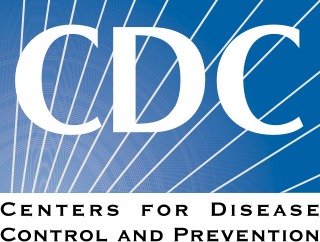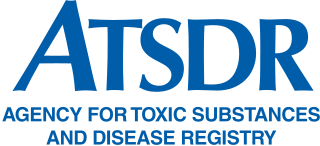Related Research Articles

The Centers for Disease Control and Prevention (CDC) is the leading national public health institute of the United States. The CDC is a United States federal agency under the Department of Health and Human Services and is headquartered in Atlanta, Georgia.
Health is a state of physical, mental and social well-being in which disease and infirmity are absent.

The United States Public Health Service (USPHS) is a division of the Department of Health and Human Services concerned with public health. It contains eight out of the department's eleven operating divisions. The Assistant Secretary for Health (ASH) oversees the PHS. The Public Health Service Commissioned Corps (PHSCC) is the federal uniformed service of the USPHS, and is one of the seven uniformed services of the United States.

Environmental health is the branch of public health concerned with all aspects of the natural and built environment affecting human health. Environmental health is focused on the natural and built environments for the benefit of human health. The major subdisciplines of environmental health are: environmental science; environmental and occupational medicine, toxicology and epidemiology.

The Agency for Toxic Substances and Disease Registry (ATSDR) is a federal public health agency within the United States Department of Health and Human Services. The agency focuses on minimizing human health risks associated with exposure to hazardous substances. It works closely with other federal, state, and local agencies; tribal governments; local communities; and healthcare providers. Its mission is to "Serve the public through responsive public health actions to promote healthy and safe environments and prevent harmful exposures." ATSDR was created as an advisory, nonregulatory agency by the Superfund legislation and was formally organized in 1985.
CHN may stand for:
The Aga Khan Development Network (AKDN) is a network of private, non-denominational development agencies founded by the Aga Khan, which work primarily in the poorest parts of Asia and Africa. Aga Khan IV succeeded to the office of the 49th hereditary Imam as spiritual and administrative leader of the Shia faith rooted Nizari Ismaili Muslim supranational union in 1957. Ismailis consist of an estimated 25-30 million adherents. The network focuses on health, education, culture, rural development, institution building and the promotion of economic development. The AKDN aims to improve living conditions and opportunities for the poor, without regard to their faith, origin or gender. Its annual budget for not-for-profit activities is approximately US $ 600 million – mainly in Africa, Asia, and the Middle East. The AKDN works in 30 countries around the world, and it employs over 80,000 paid staff, mostly in developing countries. While the agencies are secular, they are guided by Islamic ethics, which bridge faith and society.

The National Safety Council (NSC) is a 501(c)(3) nonprofit, public service organization promoting health and safety in the United States of America. Headquartered in Itasca, Illinois, NSC is a member organization, founded in 1913 and granted a congressional charter in 1953. Members include more than 55,000 businesses, labor organizations, schools, public agencies, private groups and individuals.

The Canadian Institutes of Health Research is the major federal agency responsible for funding health and medical research in Canada. It is the successor to the Medical Research Council of Canada. It aims to create new health knowledge and to translate that knowledge from the research setting into real world applications.
Health human resources (HHR) – also known as human resources for health (HRH) or health workforce – is defined as "all people engaged in actions whose primary intent is to enhance health", according to the World Health Organization's World Health Report 2006. Human resources for health are identified as one of the core building blocks of a health system. They include physicians, nursing professionals, midwives, dentists, allied health professions, community health workers, social health workers and other health care providers, as well as health management and support personnel – those who may not deliver services directly but are essential to effective health system functioning, including health services managers, medical records and health information technicians, health economists, health supply chain managers, medical secretaries and others.
The education which is related to health is also known as health education. Health education is a profession of educating people about health. Areas within this profession encompass environmental health, physical health, social health, emotional health, intellectual health, and spiritual health, as well as sexual and reproductive health education.
Health promotion is, as stated in the 1986 World Health Organization (WHO) Ottawa Charter for Health Promotion, "the process of enabling people to increase control over, and to improve, their health. To reach a state of complete physical, mental and social well-being, an individual or group must be able to identify and to realize aspirations, to satisfy needs, and to change or cope with the environment. Health is, therefore, seen as a resource for everyday life, not the objective of living. Health is a positive concept emphasizing social and personal resources, as well as physical capacities. Therefore, health promotion is not just the responsibility of the health sector, but goes beyond healthy life-styles to well-being".
A patient safety organization (PSO) is a group, institution or association that improves medical care by reducing medical errors. In the 1990s, reports in several countries revealed a staggering number of patient injuries and deaths each year due to avoidable adverse health care events. In the United States, the Institute of Medicine report (1999) called for a broad national effort to include the establishment of patient safety centers, expanded reporting of adverse events and development of safety programs in health care organizations. The organizations that developed ranged from governmental to private, and some founded by industry, professional or consumer groups. Common functions of patient safety organizations are data collection and analysis, reporting, education, funding and advocacy.
Public health laboratories are governmental reference laboratories that protect the public against diseases and other health hazards.

In medicine, rural health or rural medicine is the interdisciplinary study of health and health care delivery in rural environments. The concept of rural health incorporates many fields, including geography, midwifery, nursing, sociology, economics, and telehealth or telemedicine.

The Canadian AIDS Society (CAS) is a national coalition of community-based AIDS service organizations across Canada. Registered as a charity since 1988, CAS has a mandate to improve the response to HIV/AIDS in Canada across all sectors of society, and to support people and communities living with HIV/AIDS.

The Ontario Agency for Health Protection and Promotion (OAHPP), which has operated under the name Public Health Ontario since 2011, was established in 2008 by the Ontario Agency for Health Protection and Promotion Act of 2007.
References
- ↑ "Canadian Health Network". Canadian Centre for Occupational Health and Safety . Retrieved 2013-03-27.
- ↑ Goar, Carol (November 16, 2007). "Conservatives axe health network". Toronto Star. Retrieved 2007-12-06.